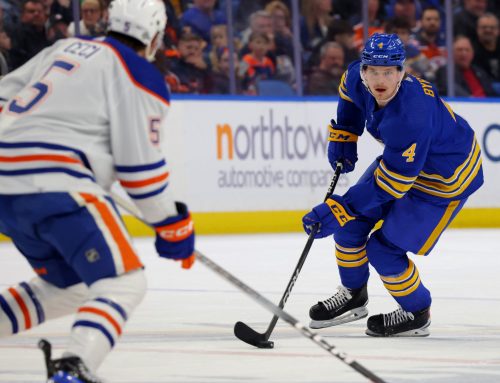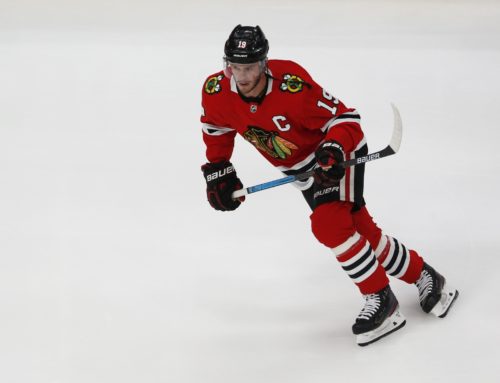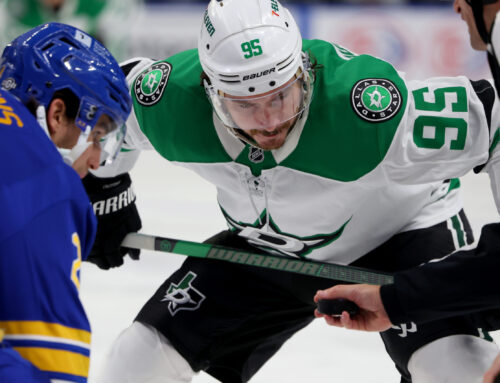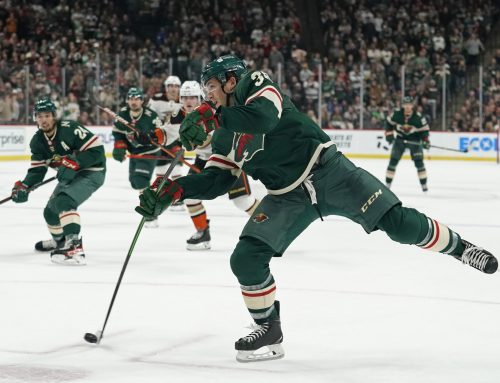
We are just a couple of days away from one of the busiest days in the NHL schedule, Free Agent Frenzy. It’s a great day for many hockey fans to relax, fire up the barbecue, and find out about how their team’s fortunes may change for the upcoming season and beyond. If you’re an Edmonton or Montreal fan, it’s a good excuse to start in on grandpa’s cough medicine before noon.
The Dobber team will be here all through free agency to provide updates and impacts of signings from a fantasy hockey angle. Be sure to check back on Dobber Hockey all day Canada Day to see which players, or line mates, could be hurt or helped with all the movement.
*
Several fantasy-relevant goaltenders will be finding a new home this summer and Pierre LeBrun gives an update on likely destinations for a few of them:
Always subject to change between now and Sunday, but at this hour on the goalie carousel, it would appear Carter Hutton is the leading option in Buffalo, Jonathan Bernier likely headed to Detroit and as we said before, Cam Ward likely to Chicago…
— Pierre LeBrun (@PierreVLeBrun) June 28, 2018
The writing was on the wall for Jonathan Bernier when the Avalanche added Philipp Grubauer and St. Louis doesn’t have (or doesn’t want to spend) the space to bring back Carter Hutton. Cam Ward going to Chicago in a backup role is interesting considering Ward hasn’t had a good season in six years.
Bernier is the one who interests me the most here. He was around league average over the last couple years as far as all-strengths save percentage is concerned – though his goals saved above average isn’t very good – and Jimmy Howard has just one year left on his deal at the age of 34. In other words, I don’t think the team will be too committed in making Howard their go-to, sure-fire number-1 goalie. This may be a hot-hand situation which could lead to good value at the draft table grabbing Bernier as a fourth goalie in 12-team leagues. Let’s see how the signings actually work out.
*
LeBrun also states that the Kings and Drew Doughty have started their dialogue towards a new contract. Doughty is part of the triumvirate of elite defencemen set to be unrestricted free agents next year along with Erik Karlsson and Oliver Ekman-Larsson.
We’ve seen the reports that OEL is expected to sign for eight years and somewhere around $8M-$8.25M per season. Of the three, though, he would be considered the lesser defenceman (all being relative here). Were Doughty to sign sometime in July, it would undoubtedly set the market for what teams can expect to pay for Karlsson.
Either way, cap league owners should be prepared for eight-figure AAVs for both Doughty and Karlsson a year from now. You’ve been warned.
*
On the Rick Nash front, there was confirmation from his agent that Nash is still unsure about even playing in 2018-19 and won’t be signing immediately on July 1st. At the least, he seems to be very much considering retirement, if not just being very careful about where he signs next.
Just a thought in dynasty leagues: now might be the time to get him extremely cheap. You should be able to get him for a lower-level prospect or some sort of pick, given the news right now is that he might retire. In the right situation, 20-25 goals is again possible.
*
This is a little too on the nose given the goings-on around the franchise:
The #Sens continue their development camp despite power outage in the area. #SensDevCamp pic.twitter.com/2kuNlrCHz5
— Brent Wallace (@tsn_wally) June 28, 2018
*
In yesterday’s Ramblings, we discussed some players with significant on-ice CorsiFor increases in 2017-18 compared to 2016-17. On-Ice CorsiFor per 60 minutes (CF/60) is the rate at which a team takes shots (shot attempts, to be exact) with a given player on the ice and is generally expressed at five-on-five. The more shots a team takes, the more opportunities for goals. More opportunities for goals means more opportunities for points. The discussion revolved around a handful of players and whether this increase was a blip or the start of a new trend.
Today we will go over the other end of the spectrum: those with significant declines in on-ice CF/60. Again, data from Natural Stat Trick with viz from CJ Turtoro using data from Corey Sznajder.
Here are the largest declines in on-ice CF/60

Let’s talk about a few of these players. Most of them aren’t worth mentioning but there are some very fantasy-relevant players.
It took a long, long time for Parise to finally hit the ice but he made his season debut on January 2nd and was actually pretty helpful from a fantasy perspective. Despite the lowest TOI/game since his rookie season in 2005-06, Parise still managed 15 goals and 119 shots in just 42 games. That’s without much success on the power play, posting one assist in over 100 minutes of PP time from his debut through the end of the campaign. As an aside, it’s worth noting he led all Wild forwards in PP minutes over those 42 games, but he shot just 8.3 percent on the PP. Expect much better power-play numbers next year if he keeps getting those minutes.
It’s worth noting the Wild were one of the few teams to see a decline in CF/60 from 2016-17 despite league-wide shot rates increasing. They have consistently out-performing their CF/60 in terms of actual goals in recent seasons, as Anaheim teams in years past had done. All the same, the team’s 3.6 percent decline in on-ice CF/60 is a far cry from Parise’s 9.9 percent decrease.
This seems to be an instance where line mates matter. Parise skated double the minutes with Mikko Koivu than Eric Staal, but his on-ice CF/60 was much better with Staal (58.76) than with Koivu (51.45). Things were even more stark in 2016-17, when his on-ice CF/60 with Staal (61.24) was much higher than with Koivu (47.98). The difference was that in 2016-17 he played considerably more minutes with Staal, whereas in 2017-18 he played a lot more with Koivu.
As long as Parise stays in the top-6 with those power-play minutes, I wouldn’t be too concerned with which centre he skates alongside at five-on-five. His health will ultimately determine his fantasy value and considering he hasn’t played 75 games in a season since 2011-12, it’s clear how to value him. He’s a late-round pick at this point with hopes he can he play 70 games.
It’s difficult what to make of Marchand’s season if only because of the flux of the top line. Marchand went through his fair share of injuries over the course of the season and had the multiple suspensions. Patrice Bergeron went through his fair share of injuries, missing 18 games total. In his games missed, Riley Nash was largely the centre Marchand skated with.
Despite all these variables, Marchand had his best offensive season considering he played just 68 games.
It’s worth first looking at Marchand’s numbers with Bergeron and with Nash:
- With Bergeron as his centre, Marchand’s on-ice CF/60 was 66.63
- With Nash as his centre, Marchand’s on-ice CF/60 was 57.61
It shouldn’t surprise anyone that the Bruins were more productive offensively when Marchand had Bergeron as his pivot, but that mark of 66.63 is still lower than Marchand’s total on-ice CF/60 in 2016-17 (69.36), and lower than Marchand’s on-ice CF/60 in 2016-17 when looking at his time with Bergeron (70.43). There’s not much reason to get too hyped over a 5.7 percent on-ice CF/60 decline in the Bergeron+Marchand numbers, though, given the injuries outlined above.
Despite the injuries, despite the suspensions, and despite the decline in on-ice CF/60, Marchand did a better job at controlling the puck, helping his team exit their zone and enter the offensive zone in an attacking manner than the year before:

Even considering everything that happened, it was a special year for Marchand. A full season with that top line intact should see Marchand easily repeat his 2017-18 performance if not exceed it. It’ll be interesting to see what his ADP will be i.e. if he sneaks into the late first round in non-real time stats leagues.
Simmonds has never really been a monster driver of the play. If you go back over the last five years, it’s a mixed bag. Decent driving offensively, not so much preventing defensively. He’s a finisher. He’s a guy who digs pucks loose and gets to the net. And that’s perfectly fine. Every team can use the type of player Simmonds is. He is great at what he does, and if he does get traded, there should be a long line of suitors.
His numbers did fall off this year but it’s not something that I think is concerning. Through injury and demotion at times, Simmonds played just 975 minutes at five-on-five. Of those 975 minutes, he skated with Valtteri Filppula for 400 of them, roughly 41 percent of his five-on-five TOI. In those 400 minutes, his on-ice CF/60 was 52.03. In his 328 minutes playing with Nolan Patrick, that number ballooned to 58.13. It’s no secret that Filppula is far from the player he was years ago and at this point it’s a question of if he can even find a regular role in the NHL now. Simmonds played over 40 percent of his five-on-five ice time with a guy who is, at best, a fourth-line centre at this point of his career. That is in contrast to his 44-plus percent of ice time with Claude Giroux in 2016-17. It’s no wonder Simmonds’ numbers took a tumble.
There are also the injuries. Oh man, the injuries. He played through a broken ankle, torn pelvis, and pulled groin. He also tore a ligament in his thumb. Despite all this, he missed just seven games and still managed 24 goals.
With Filppula garnering so much time as his pivot, and a litany of injuries that would make a player’s entire career, let alone season, look painful, Simmonds’ zone entry/exit numbers, as well as his shot rates and contributions, all declined:
.png)
There is still some uncertainty this summer, namely that Simmonds’ name keeps coming up in trade talks. Whether he’s back with the Flyers or somewhere else could have an impact on his value. His fantasy value, at least on the production side, largely comes from the power play, so if he is traded, it needs to be somewhere he’s going to be on a heavily-used top PP unit.
Regardless, it’s amazing Simmonds had the season he had. Sure, all his numbers declined in pretty much every important category but it’s a credit to him that they didn’t decline even more than they did. Maybe a down year will provide good value at the draft table come September. In roto leagues, he’s generally been a lock for a top-50 player. If he’s healthy in the right situation, he can be that player again.





 CHI
CHI SEA
SEA FLA
FLA DAL
DAL WPG
WPG CBJ
CBJ L.A
L.A S.J
S.J N.J
N.J ARI
ARI
